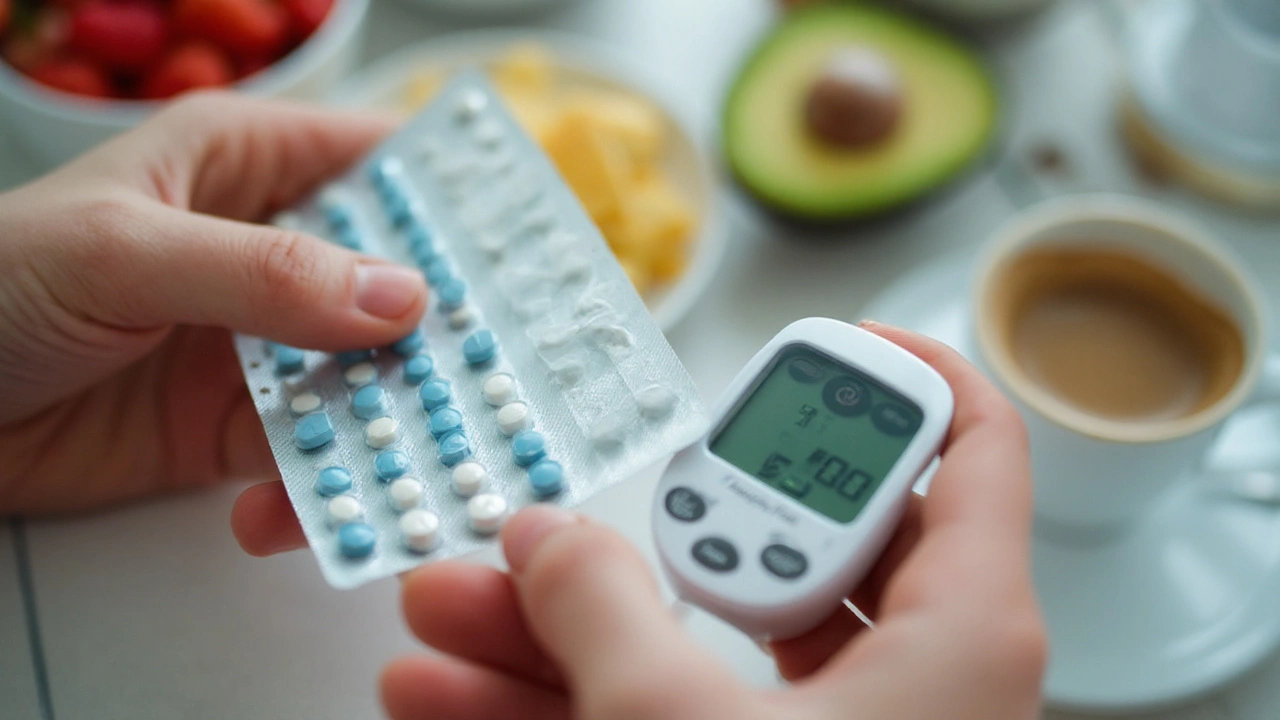Actoplus Met: Uses, Dosage, Benefits & Side Effects Explained
 Sep, 21 2025
Sep, 21 2025
TL;DR
- Actoplus Met combines metformin and sitagliptin to lower blood sugar in type 2 diabetes.
- Typical starting dose is 500mg/50mg once daily, taken with meals.
- Works by decreasing liver glucose production and enhancing insulin release after meals.
- Common side effects include stomach upset, nausea, and mild headache.
- Not for people with severe kidney problems, liver disease, or a history of lactic acidosis.
What Is Actoplus Met and How It Works
Actoplus Met is a fixed‑dose combo pill that brings together two well‑known diabetes drugs: metformin and sitagliptin. Metformin has been the backbone of type 2 diabetes care for decades; it tells the liver to cut back on glucose output and makes muscle cells more sensitive to insulin. Sitagliptin belongs to the DPP‑4 inhibitor family - it blocks the enzyme that destroys incretin hormones, which in turn ramps up insulin release after you eat and slows down glucagon.
When you swallow a single tablet, both mechanisms kick in at the same time. The result is a smoother, more predictable drop in post‑meal blood sugar without the need for two separate prescriptions. For many patients, that convenience translates into better adherence and, ultimately, better long‑term control.
Dosage Guidelines and Administration Tips
Doctors usually start adults on the lowest available strength: 500mg metformin / 50mg sitagliptin once a day, taken with the first main meal. If blood sugar stays above target after a few weeks, the dose can be stepped up to 850mg/50mg or 1000mg/100mg, again with food. The key is to avoid taking the tablet on an empty stomach - that’s where most gastrointestinal complaints arise.
Here’s a quick cheat‑sheet you can print out:
- Check your prescription - note the total daily dose and the “take with food” instruction.
- Place the pill with a glass of water at the start of breakfast (or lunch if that’s your main meal).
- Never crush or split the tablet; the coating protects the metformin from degrading.
- If you miss a dose, take it as soon as you remember **provided it’s still within a reasonable time window**. Skip it if it’s almost time for the next dose - don’t double up.
- Keep a log of fasting blood glucose and post‑meal readings for the first month; share trends with your clinician.
Special populations need tweaks. For patients with moderate kidney impairment (eGFR 30‑45mL/min), the metformin component is usually reduced to 500mg, and the total daily dose should not exceed 1000mg. People over 75 may also start at the low end to limit gastrointestinal side effects.
Potential Benefits and Who Should Use It
When the combo hits the sweet spot, users often see a 0.5‑1.0% drop in HbA1c within three months, comparable to adding a second oral agent but with fewer pills. That reduction translates into a lower risk of micro‑vascular complications such as retinopathy and nephropathy.
Ideal candidates include:
- Adults newly diagnosed with type 2 diabetes who are already on metformin alone but need extra glucose control.
- Patients who struggle with taking multiple pills each day and prefer a single‑tablet regimen.
- Individuals without severe renal or hepatic disease, and who have no history of pancreatitis.
On the flip side, the drug isn’t a magic bullet for everyone. Those with type 1 diabetes, gestational diabetes, or a known allergy to either ingredient should stay clear. Likewise, anyone on certain heart failure meds (e.g., certain diuretics) may need dose adjustments because of the metformin component.

Side Effects, Interactions, and Safety Precautions
Even the best‑designed medicine brings a risk profile. The most common complaints with Actoplus Met are:
- Stomach upset, bloating, or mild diarrhea - usually settle after a week or two.
- Nausea, especially if you skip the meal cue.
- Rarely, a metallic taste or loss of appetite.
Serious but uncommon events include:
- Lactic acidosis - a build‑up of lactate that can be life‑threatening. Risk spikes if kidney function drops sharply.
- Pancreatitis - watch for severe upper‑abdominal pain that radiates to the back.
- Hypoglycemia - more likely if you combine the combo with insulin or a sulfonylurea.
Key drug interactions:
| Drug/Class | Interaction | Management |
|---|---|---|
| Contrast dyes (iodinated) | Can precipitate acute kidney injury, raising lactic acidosis risk. | Hold metformin for 48hrs before and after contrast exposure. |
| Beta‑blockers | Mask hypoglycemia symptoms. | Monitor blood glucose more closely. |
| Alcohol (excessive) | Raises lactic acidosis risk. | Limit intake; avoid binge drinking. |
Before starting, your doctor will run baseline labs: fasting glucose, HbA1c, kidney function (eGFR), and liver enzymes. Ongoing monitoring every 3‑6 months keeps everything on track.
Mini FAQ
- Can I take Actoplus Met if I’m already on insulin? Yes, but dose adjustment is likely needed to avoid low blood sugar.
- Is the medication safe during pregnancy? No - both metformin and sitagliptin cross the placenta; safer alternatives exist.
- What should I do if I develop persistent diarrhea? Contact your clinician; they may lower the metformin dose or switch to an extended‑release formulation.
- Does weight loss occur? Metformin can cause modest weight loss; sitagliptin is weight‑neutral.
- Can I travel with the pill? Absolutely - just keep it in its original container, out of direct heat.
Next Steps & Troubleshooting
If you’re considering Actoplus Met, schedule a quick visit with your GP or endocrinologist. Bring a list of current meds, recent labs, and any kidney‑related concerns. After you start the therapy, keep a daily log of meals, blood sugar readings, and any side effects. Use the log to spot patterns - for example, if nausea only shows up when you miss breakfast, that’s a clear cue to never skip the meal.
Should problems pop up:
- Gastro‑issues persisting beyond two weeks: Ask for a slower titration or switch to metformin XR.
- Signs of hypoglycemia (shakiness, sweating, confusion): Eat a fast‑acting carbohydrate and check your glucose; discuss dose reduction with your doctor.
- Lactate‑related symptoms (muscle pain, rapid breathing): Seek emergency care - this could signal lactic acidosis.
Remember, no single pill replaces a healthy lifestyle. Pair Actoplus Met with balanced meals, regular walking, and routine check‑ups for the best outcomes.

Stephanie Deschenes
September 23, 2025 AT 02:40Been on Actoplus Met for 18 months now. The stomach stuff faded after the first week if I took it with breakfast. No more double pills - huge win for my routine. My A1c dropped from 7.8 to 6.4. Not magic, but it works if you pair it with actual food and not just coffee.
Also, avoid the generic versions. The brand coating makes a difference in how your gut handles it.
Cynthia Boen
September 25, 2025 AT 01:06This is just another Big Pharma cash grab. Metformin alone works fine for most people. They just bundled it with sitagliptin so they could charge double and keep you on it forever. You don’t need two drugs to manage type 2 - just eat less sugar and move your body.
Amanda Meyer
September 25, 2025 AT 14:51I appreciate the thorough breakdown, but I’m concerned about the lack of emphasis on long-term metformin use and B12 deficiency. Studies show up to 30% of long-term users develop subclinical deficiency, which can mimic neuropathy or fatigue. Shouldn’t annual B12 monitoring be standard here?
Also, the table mentions contrast dyes but doesn’t clarify that this applies to IV contrast only - oral contrast is fine. That distinction matters for patients scheduling CT scans.
Jesús Vásquez pino
September 27, 2025 AT 09:28Yo, I tried this after my doc pushed it on me. First week I felt like I was gonna puke every time I ate. Took it with dinner instead of breakfast and boom - no more nausea. Also, I started walking 20 min after meals and my numbers dropped even more. Don’t just take the pill - move. Your pancreas will thank you.
And yeah, skip the alcohol. I learned that the hard way after one beer and a 3 a.m. panic attack from low sugar.
hannah mitchell
September 27, 2025 AT 11:45Just started this last month. Still getting used to it. Haven’t noticed much change yet, but at least I’m not taking three pills anymore. Fingers crossed it sticks.
vikas kumar
September 28, 2025 AT 05:38As someone from India where diabetes is super common, I’ve seen this combo help a lot of people who can’t afford insulin or struggle with pill fatigue. But here’s the thing - in rural areas, people forget to take it with food because they’re eating chapati and tea at 7 a.m. and then work in the fields.
Maybe add a note: ‘Take with your first solid meal, not just tea or juice.’ That could prevent a lot of GI issues.
Also, metformin XR is cheaper here and gentler - worth asking your doc if you’re sensitive.
Vanessa Carpenter
September 28, 2025 AT 17:55My mom’s been on this for two years. She’s 72. The biggest win? She actually remembers to take it because it’s one pill. Before, she’d mix up her metformin and glipizide and either double-dose or skip. This fixed that. No dramatic changes in energy, but her A1c’s stable. That’s enough for us.
Bea Rose
September 29, 2025 AT 14:13The article ignores the fact that sitagliptin increases the risk of pancreatic cancer in long-term users. The FDA issued a warning in 2013. This combo is not safer - it’s just more convenient for pharmaceutical profits. Stick with metformin and lifestyle changes. Everything else is optional.